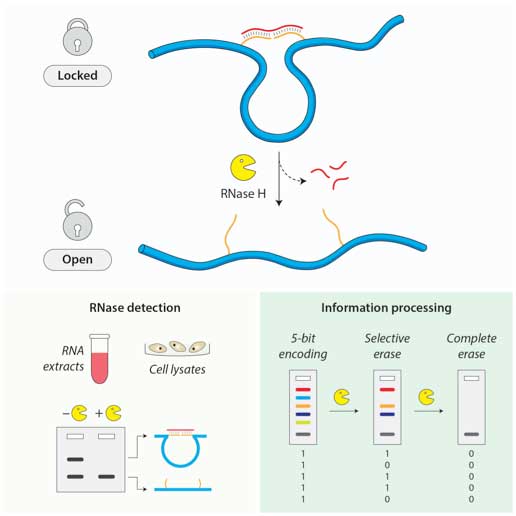| Jul 22, 2020 | |
DNA nanoswitches respond to RNA degrading enzymes, with applications in biosensing and molecular computing(Nanowerk News) A team of researchers from the University at Albany, State University of New York has developed DNA nanoswitches that can detect the presence of ribonucleases (RNases) which are enzymes that degrade RNA. |
|
| RNases can pose problems for biomedical research involving RNA, so detecting RNases can help to identify contamination in biological samples. RNases also have biological relevance, such as in the proliferation of retroviruses such as HIV, where RNase inhibitors have been considered for drug development. | |
| The study, led by Arun Richard Chandrasekaran and Ken Halvorsen of The RNA Institute at State University of New York at Albany was published in Cell Reports Physical Sciences ("Ribonuclease-Responsive DNA Nanoswitches"). The work also includes contribution by undergraduate researcher Ruju Trivedi. | |
| Current techniques for RNase detection typically involve fluorescence analyses and multiple processing steps. | |
| The team used structure-changing DNA nanoswitches that turn from "signal-on" to "signal-off" in the presence of RNases, giving a direct readout using the common lab method of gel electrophoresis. In the study, the researchers were able to detect low levels of RNase H and used the detection to screen enzyme inhibitors that are considered as drug candidates for HIV. | |
 |
|
| DNA nanoswitches that change conformation in the presence of ribonucleases (RNases). This signal change can be used for detecting RNases and in molecular information processing. (Image courtesy of (click on image to enlarge) | |
| In addition to RNase detection, the scientists used the nanoswitches to act as a molecular information processing system. Expanding previous work on DNA-based rewritable memory (Nucleic Acids Research, "Addressable configurations of DNA nanostructures for rewritable memory"), the researchers encoded 5-bit information into DNA nanoswitches and used RNases as molecular erasers to delete all or part of this written information. | |
| The team believes that the new development adds value to the existing suite of applications of the DNA nanoswitches that includes detection of nucleic acid biomarkers such as microRNAs (Science Advances, "Cellular microRNA detection with miRacles: microRNA- activated conditional looping of engineered switches"), viral RNAs including SARS-CoV-2 (bioRxiv preprint, "Programmable low-cost DNA-based platform for viral RNA detection") and as a platform for analyzing molecular interactions (Nature Methods, "DNA nanoswitches: a quantitative platform for gel-based biomolecular interaction analysis"). |
| Source: The RNA Institute, State University of New York at Albany | |
|
Subscribe to a free copy of one of our daily Nanowerk Newsletter Email Digests with a compilation of all of the day's news. |
